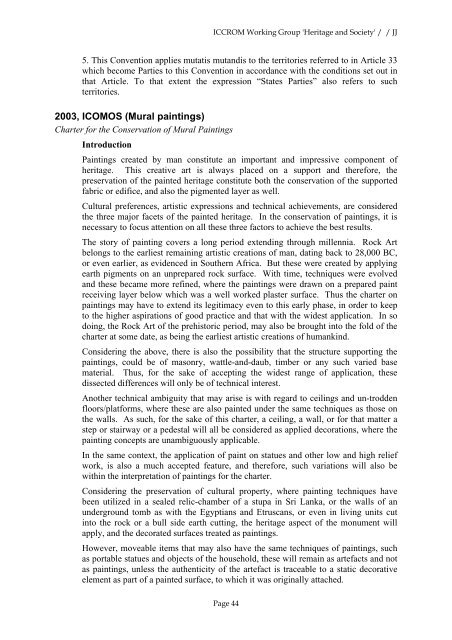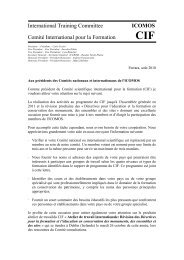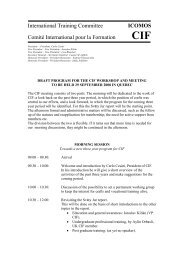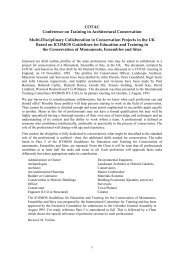Definition of Cultural Heritage -- References to ... - CIF - Icomos
Definition of Cultural Heritage -- References to ... - CIF - Icomos
Definition of Cultural Heritage -- References to ... - CIF - Icomos
Create successful ePaper yourself
Turn your PDF publications into a flip-book with our unique Google optimized e-Paper software.
ICCROM Working Group '<strong>Heritage</strong> and Society' / / JJ<br />
5. This Convention applies mutatis mutandis <strong>to</strong> the terri<strong>to</strong>ries referred <strong>to</strong> in Article 33<br />
which become Parties <strong>to</strong> this Convention in accordance with the conditions set out in<br />
that Article. To that extent the expression “States Parties” also refers <strong>to</strong> such<br />
terri<strong>to</strong>ries.<br />
2003, ICOMOS (Mural paintings)<br />
Charter for the Conservation <strong>of</strong> Mural Paintings<br />
Introduction<br />
Paintings created by man constitute an important and impressive component <strong>of</strong><br />
heritage. This creative art is always placed on a support and therefore, the<br />
preservation <strong>of</strong> the painted heritage constitute both the conservation <strong>of</strong> the supported<br />
fabric or edifice, and also the pigmented layer as well.<br />
<strong>Cultural</strong> preferences, artistic expressions and technical achievements, are considered<br />
the three major facets <strong>of</strong> the painted heritage. In the conservation <strong>of</strong> paintings, it is<br />
necessary <strong>to</strong> focus attention on all these three fac<strong>to</strong>rs <strong>to</strong> achieve the best results.<br />
The s<strong>to</strong>ry <strong>of</strong> painting covers a long period extending through millennia. Rock Art<br />
belongs <strong>to</strong> the earliest remaining artistic creations <strong>of</strong> man, dating back <strong>to</strong> 28,000 BC,<br />
or even earlier, as evidenced in Southern Africa. But these were created by applying<br />
earth pigments on an unprepared rock surface. With time, techniques were evolved<br />
and these became more refined, where the paintings were drawn on a prepared paint<br />
receiving layer below which was a well worked plaster surface. Thus the charter on<br />
paintings may have <strong>to</strong> extend its legitimacy even <strong>to</strong> this early phase, in order <strong>to</strong> keep<br />
<strong>to</strong> the higher aspirations <strong>of</strong> good practice and that with the widest application. In so<br />
doing, the Rock Art <strong>of</strong> the prehis<strong>to</strong>ric period, may also be brought in<strong>to</strong> the fold <strong>of</strong> the<br />
charter at some date, as being the earliest artistic creations <strong>of</strong> humankind.<br />
Considering the above, there is also the possibility that the structure supporting the<br />
paintings, could be <strong>of</strong> masonry, wattle-and-daub, timber or any such varied base<br />
material. Thus, for the sake <strong>of</strong> accepting the widest range <strong>of</strong> application, these<br />
dissected differences will only be <strong>of</strong> technical interest.<br />
Another technical ambiguity that may arise is with regard <strong>to</strong> ceilings and un-trodden<br />
floors/platforms, where these are also painted under the same techniques as those on<br />
the walls. As such, for the sake <strong>of</strong> this charter, a ceiling, a wall, or for that matter a<br />
step or stairway or a pedestal will all be considered as applied decorations, where the<br />
painting concepts are unambiguously applicable.<br />
In the same context, the application <strong>of</strong> paint on statues and other low and high relief<br />
work, is also a much accepted feature, and therefore, such variations will also be<br />
within the interpretation <strong>of</strong> paintings for the charter.<br />
Considering the preservation <strong>of</strong> cultural property, where painting techniques have<br />
been utilized in a sealed relic-chamber <strong>of</strong> a stupa in Sri Lanka, or the walls <strong>of</strong> an<br />
underground <strong>to</strong>mb as with the Egyptians and Etruscans, or even in living units cut<br />
in<strong>to</strong> the rock or a bull side earth cutting, the heritage aspect <strong>of</strong> the monument will<br />
apply, and the decorated surfaces treated as paintings.<br />
However, moveable items that may also have the same techniques <strong>of</strong> paintings, such<br />
as portable statues and objects <strong>of</strong> the household, these will remain as artefacts and not<br />
as paintings, unless the authenticity <strong>of</strong> the artefact is traceable <strong>to</strong> a static decorative<br />
element as part <strong>of</strong> a painted surface, <strong>to</strong> which it was originally attached.<br />
Page 44














